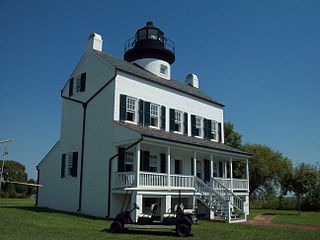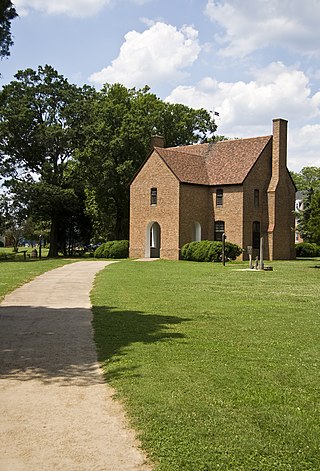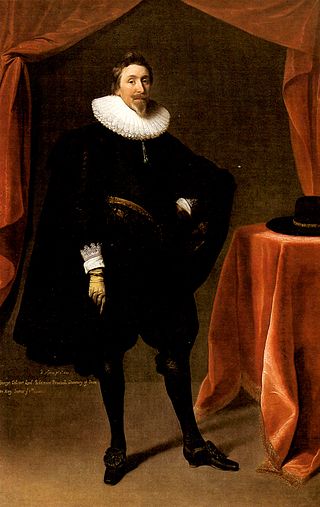
The Maryland Toleration Act, also known as the Act Concerning Religion, the first law in North America requiring religious tolerance for Christians. It was passed on April 21, 1649, by the assembly of the Maryland colony, in St. Mary's City in St. Mary's County, Maryland. It created one of the pioneer statutes passed by the legislative body of an organized colonial government to guarantee any degree of religious liberty. Specifically, the bill, now usually referred to as the Toleration Act, granted freedom of conscience to all Christians. Historians argue that it helped inspire later legal protections for freedom of religion in the United States. The Calvert family, who founded Maryland partly as a refuge for English Catholics, sought enactment of the law to protect Catholic settlers and those of other religions that did not conform to the dominant Anglicanism of Britain and her colonies.

St. Mary's County, established in 1637, is a county located in the U.S. state of Maryland. As of the 2020 census, the population was 113,777. Its county seat is Leonardtown. The name is in honor of Mary, the mother of Jesus. St. Mary's County comprises the California-Lexington Park, Maryland Metropolitan Statistical Area, which also is included in the Washington-Baltimore-Arlington, DC-MD-VA-WV-PA Combined Statistical Area. It is part of the Southern Maryland region. The county was the home to the first Maryland Colony, and the first capital of the Colony of Maryland. Settled by English Catholics, it is considered to be the birthplace of religious freedom in North America, at a time when the British colonies were settled primarily by Protestants. The county is home to the Patuxent River Naval Air Station and St. Mary's College of Maryland. Traditionally, St. Mary's County has been known for its unique and historic culture of Chesapeake Bay tidewater farming, fishing, and crabbing communities. But with the advent of the military bases, growth of an extensive defense contractor presence, and the growth of St. Mary's College of Maryland, as well as increasing numbers of long-distance Washington, D.C. commuters, it has been undergoing a decades-long transformation which has seen the county's population double since 1970.

Cecil Calvert, 2nd Baron Baltimore was an English politician, peer and lawyer who was the first proprietor of Maryland. Born in Kent in 1605, he inherited the proprietorship after the death of his father, George Calvert, 1st Baron Baltimore, for whom it had been intended. Calvert proceeded to establish and manage the Province of Maryland as a proprietary colony for English Catholics from his English country house of Kiplin Hall in North Yorkshire.

Baron Baltimore, of Baltimore, County Longford, was a title in the Peerage of Ireland. It was created in 1625 and ended in 1771, upon the death of its sixth-generation male heir, aged 40. Holders of the title were usually known as Lord Baltimore for short.

St. Mary's City is a former colonial town that was founded in March 1634, as Maryland's first European settlement and capital. It is now a state-run historic area, which includes a reconstruction of the original colonial settlement and a designated living history venue and museum complex. Half the area is occupied by the campus of St. Mary's College of Maryland. The entire area contains a community of about 933 permanent residents and some 1,400 students living in campus dorms and apartments.

The Province of Maryland was an English and later British colony in North America from 1634 until 1776, when it made common cause with the group of Thirteen Colonies in rebellion against Great Britain and, finally in 1781—as the 13th signatory to the Articles of Confederation—it ratified its perpetual union with that group as the state of Maryland. The province's first settlement and capital was St. Mary's City, located at the southern end of St. Mary's County, a peninsula in the Chesapeake Bay that is bordered by four tidal rivers.

George Calvert, 1st Baron Baltimore was an English peer and politician. He achieved domestic political success as a member of parliament and later Secretary of State under King James I. He lost much of his political power after his support for a failed marriage alliance between Prince Charles and the Spanish House of Habsburg royal family. Rather than continue in politics, he resigned all of his political offices in 1625 except for his position on the Privy Council and declared his Catholicism publicly. He was created Baron Baltimore in the Peerage of Ireland upon his resignation. Baltimore Manor was located in County Longford, Ireland.

William Claiborne also, spelled Cleyburne was an English pioneer, surveyor, and an early settler in the colonies/provinces of Virginia and Maryland and around the Chesapeake Bay. Claiborne became a wealthy merchant and planter, as well as a major political figure in the mid-Atlantic colonies. He featured in disputes between the colonists of Virginia and the later settling of Maryland, partly because of his earlier trading post on Kent Island in the mid-way of the Chesapeake Bay, which provoked the first naval military battles in North American waters. Claiborne repeatedly attempted and failed to regain Kent Island from the Maryland Calverts, sometimes by force of arms, after its inclusion in the lands that were granted by a 1632 Royal Charter to the Calvert family. Kent Island had become Maryland territory after the surrounding lands were granted to Sir George Calvert, first Baron and Lord Baltimore (1579–1632) by the reigning King of England, Charles I.

Leonard Calvert was the first proprietary governor of the Province of Maryland. He was the second son of The 1st Baron Baltimore (1579–1632), the first proprietor of Maryland. His elder brother Cecil (1605–1675), who inherited the colony and the title upon the death of their father George, April 15, 1632, appointed Leonard as governor of the Colony in his absence.

Elihu Emory Jackson, a member of the United States Democratic Party, was the 41st Governor of Maryland in the United States from 1888 to 1892. He was born in 1837 in Delmar, Maryland and died in 1907 in the City of Baltimore, Maryland. He is buried at the Parsons Cemetery in Salisbury, Maryland, the county seat of Wicomico County. He was part owner of Pemberton Hall, listed on the National Register of Historic Places in 1971.

Maryland Day is a legal holiday in the U.S. state of Maryland. It is observed on the anniversary of the March 25, 1634, landing of the first European settlers in the Province of Maryland, the third English colony to be settled in British North America. On this day settlers from The Ark and The Dove first set foot onto Maryland soil, at St. Clement's Island in the Potomac River. The settlers were about 150 in number, departed from Gravesend on the Thames River downstream from London. Three Jesuit priests were collected from Cowes on the Isle of Wight in England where they avoided having to give the oath of allegiance and supremacy to the King. The colony's grant was renewed to Cecil Calvert, 2nd Baron Baltimore, (1605-1675), two years prior by Charles I of England, after first being given to his father Sir George Calvert, 1st Baron Baltimore, (1574-1632), along with the title of "Lord Baltimore", and a first grant of the Province of Avalon, in the Newfoundland Colony,, who had served the King in many official and personal capacities as Secretary of State, 1619-1625. In thanksgiving for the safe landing, Jesuit Father Andrew White celebrated the Mass for the colonists led by the younger brother of Lord Baltimore, Leonard Calvert, (1606-1647), who served as the first governor, and perhaps for the first time ever in this part of the world on the first landing at Blackistone Island, later known as St. Clement's Island off the northern shore of the Potomac River, which was the new border between the new colony and the earlier English settlements in Virginia) and erected a large cross. The landing coincided with the Feast of the Annunciation, a holy day honoring Mary, and the start of the new year in England's legal calendar. Maryland Day on 25 March celebrates the 1634 landing at St Clements. Later the colonists and their two ships sailed further back down river to the southeast to settle a capital at St. Mary's City near the point where the Potomac flows into the Chesapeake Bay.
Richard Ingle (1609–1653) was an English seaman, tobacco trader, privateer, and pirate in colonial Maryland. Along with another Protestant rebel, Captain William Claiborne, Ingle waged war against Lord Baltimore and Maryland Catholics in the name of English Parliament after his ship was seized and confiscated, siding with the Maryland Puritans in a period known as the "Plundering Time" during which unrest and lawlessness were widespread in the colony. Ingle and his men attacked ships and captured the colonial capital of the proprietary government in St. Mary's City, removing the Catholic Governor Lord Baltimore from power, in 1645. Most of Ingle's life and background are unknown.
Thomas Cornwallis was an English politician and colonial administrator. Cornwallis served as one of the first Commissioners of the Province of Maryland, and Captain of the colony's military during the early years of settlement. In a 1638 naval engagement with Virginian colonists, he captured Kent Island in Maryland.

The Yaocomico, also spelled Yaocomaco, were an Algonquian-speaking Native American group who lived along the north bank of the Potomac River near its confluence with the Chesapeake Bay in the 17th century. They were related to the Piscataway, the dominant nation north of the Potomac.

Andrew White, SJ was an English Jesuit missionary who was involved in the founding of the Maryland colony. He was a chronicler of the early colony, and his writings are a primary source on the land, the Native Americans of the area, and the Jesuit mission in North America. For his efforts in converting and educating the native population, he is frequently referred to as the "Apostle of Maryland." He is considered a forefather of Georgetown University, and is memorialized in the name of its White-Gravenor building, a central location of offices and classrooms on the university's campus.
Thomas Greene of Bobbing, Kent, 2nd Proprietary Governor of Maryland was an early settler of the Maryland colony and second Provincial Governor of the colony from 1647 to 1648.

The Battle of the Severn was a skirmish fought on March 25, 1655, on the Severn River at Horn Point, across Spa Creek from Annapolis, Maryland, in what at that time was referred to as the Puritan settlement of "Providence", and what is now the neighborhood of Eastport. It was an extension of the conflicts that formed the English Civil War, pitting the forces of Puritan settlers against forces aligned with Lord Baltimore, then Lord Proprietor of the colony of Maryland. It has been suggested by Radmila May that this was the "last battle of the English Civil War."

St. Ignatius Roman Catholic Church, also known as St. Inigoes Church or The Cove Church, is a historic Catholic parish located in St. Inigoes, St. Mary's County, Maryland. It is a direct descendant of Maryland's first Catholic chapel, in St. Mary's City, whose communicants formed the first nucleus of American Catholicism. The parish fell under the umbrella of the first establishment of religious freedom in America by George Calvert and his sons, who established the Maryland colony as a refuge for persecuted Catholics.
St. Inigoes, sometimes called St. Inigoes Shores, is a small, rural, unincorporated farming, fishing and crabbing community at the southern end of St. Mary's County in the U.S. state of Maryland that is undergoing a transition to small residential subdevelopment plots. Its western side is bordered by a number of coves and creeks that are connected to the St. Marys River, a brackish tidal tributary, near where it feeds into the mouth of the Potomac River and close to its entry point into the Chesapeake Bay.

The Ark was a 400-ton English merchant ship hired in 1633 by Cecil Calvert, 2nd Baron Baltimore to bring roughly 140 English colonists and their equipment and supplies to the new colony and Province of Maryland, one of the original Thirteen Colonies of British North America on the Atlantic Ocean eastern seaboard. On the historic trans-oceanic voyage from England in late 1633 and early 1634, The Ark was accompanied by the smaller 40-ton pinnace Dove.


















